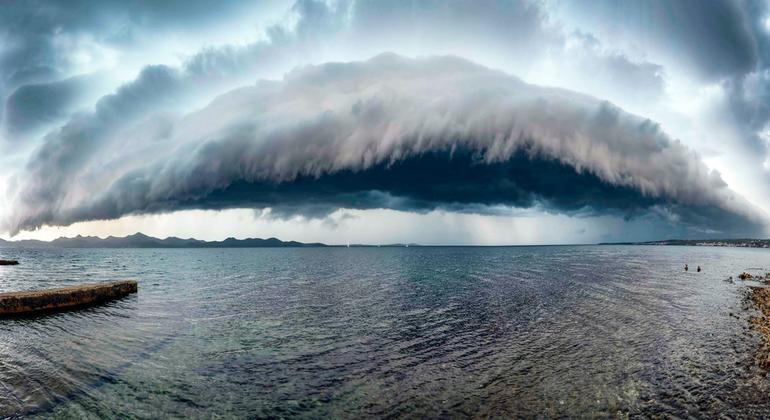Human, economic, environmental costs of climate change on the rise: WMO

The new WMO Global Climate Reports show that the last eight years were the eight warmest on recordand sea level rise and ocean warming hit new high. Record levels of greenhouse gases are causing “climate changes on land, in the ocean and in the atmosphere”.
The organization says its report, released ahead of this year Mother Earth Dayechoed UN Secretary-General António Guterres’ call for “The deeper, faster the emission cut to limit global warming to 1.5 degrees Celsius”, as well as “massively scaled-up investment in adaptation and resilience, especially for the most vulnerable countries and regions that have done the least to cause the crisis”.
WMO Secretary General, Professor Petteri Taalas, said that between greenhouse gas emissions and climate change, “the world’s population continues to be heavily impacted by extreme weather and climate events“. He emphasized that last year, “the continuing drought in East Africa, record rainfall in Pakistan and heat waves recorded in China and Europe affected millions, creates food insecurity, increases mass migration, and costs billions of dollars in loss and damage. “
WMO highlights the importance of investing in climate monitoring and early warning systems to help reduce the human impacts of extreme weather. The report also indicated that today, Advanced technology makes transition to renewable energy “cheaper and more accessible than ever”.
The hottest years on record
Them Global Climate The report complements the Intergovernmental Panel on Climate Change’s (IPCC) Sixth Assessment Report released a month ago, which includes data up to 2020.
The latest WMO figures show that global temperatures have continued to rise, making the years 2015 to 2022 the eighth warmest since regular tracking began in 1850. WMO notes that this is with three consecutive years of cooling La Niña weather pattern.
The WMO said that the concentrations of the three main greenhouse gases, which trap heat in the atmosphere – carbon dioxide, methane, and nitrous oxide – reached record highs in 2021, which is the latest year for which consolidated data is availableand there are indications of a further increase in 2022.
References ‘off the charts’
According to the report, “melting of glaciers and sea level rise – which will also reach record levels in 2022 – will continued for thousands of years“. The WMO also revealed that “Antarctic sea ice fell to its lowest extent on record and the melting of some European glaciers is, literally, off the charts”.
Sea level rise, which threatens the life of coastal areas and sometimes entire countries, not only by melting glaciers and ice caps in Greenland and Antarctica, but also by the expansion of the size of the oceans due to heat. The WMO notes that ocean warming has “peaked over the past two decades”.
Seasonal floods are a part of life in Chittagong, Bangladesh.
Fatal consequences
The report examines the various socio-economic impacts of extreme weather, which have devastating destruction in the lives of the most vulnerable around the world. Five consecutive years of drought in East Africa, combined with other factors such as armed conflict, has brought devastating food insecurity to 20 million people across the region.
Massive flooding in Pakistan caused by heavy rains in July and August last year has killed more than 1,700 people, while affecting some 33 million. WMO shows that the total damage and economic losses are estimated at $ 30 billion, and that in October 2022, almost 8 million people have been displaced by floods.
The report also notes that in addition to putting more people on the move, throughout the year, hazardous weather and climate-related events occur. “Deteriorating conditions” for many of the 95 million people already living in displacement.
Threats to ecosystems
The environmental effects of climate change are another focus of the report, which highlights changes in frequent events in nature, “such as when trees bloom, or birds migrate”. The flowering of cherry trees in Japan has been traced since the ninth century, and in 2021 the date of the event is the oldest recorded in 1,200 years.
As a result of such changes, the whole ecosystem can be upgraded. The WMO noted that the arrival times in the spring of more than a hundred species of European migratory birds in the past five years “reveal increasingly irregular levels to other spring events”, such as the timing of the trees leaves and insects are going, which is important for the bird’s survival.
The report states that these irregularities “are likely to have contributed to population decline in some migratory speciesespecially the sub-Saharan winters”, and to the ongoing destruction of biodiversity.
The end of the ‘war on nature’
In his message on Earth Day, UN chief Mr. Guterres warned that “Biodiversity is collapsing as a million species teeter on the brink of extinction“, and called on the world to end “endless and unjust wars on nature”, stressing that “we have the tools, knowledge, and solutions” to combat climate change.
Last month, Mr. Guterres called an Advisory Council of top UN officials, private sector and civil society leaders, to help speed up a global initiative aimed at protecting all countries language through life-saving early warning systems by 2027. Coordinating action announced, initially in 30 countries particularly vulnerable to extreme weather, including Small Island Developing States and Least Developed Countries more than.
Early Warning for All
WMO Secretary General Professor Petteri Taalas said on Friday that some hundred countries currently do not have adequate weather services in place, and that the UN Early Warnings for All Initiative “aims to fill the existing capacity gap to ensure that everyone on earth is protected by early warning services”.
Mr. Taalas explained that “achieving this ambitious task requires the improvement of observation networks, investments in early warning, water and weather service capabilities.” It also emphasized the effectiveness of cooperation between UN agencies in addressing the human impacts of climate events, especially in reducing deaths and economic losses.







